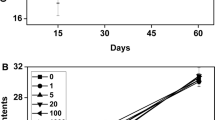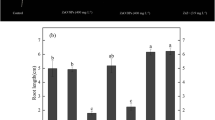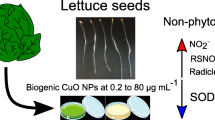Abstract
Information on the phytotoxicity of nanoparticles (NPs) at low concentrations (e.g., ppb to low ppm) is scarce. Therefore, this study was conducted to assess the effects of laboratory-prepared Cu, Zn, Mn, and Fe oxide NPs in low concentrations (<50 ppm) on the germination of lettuce (Lactuca sativa) seeds in a water medium. The data showed that CuO NPs were slightly more toxic than Cu ions while the toxicity of ZnO NPs was similar to that of Zn ions, and MnOx NPs and FeOx NPs were not only less toxic than their ionic counterparts but also significantly stimulated the growth of lettuce seedlings by 12–54 %. This study showed that manufactured NPs were not always more toxic than other chemical species containing the same elements. Instead, Mn or Fe NPs can significantly enhance plant growth and have the potential to be effective nanofertilizers for increasing agronomic productivity.






Similar content being viewed by others
References
Adams, L. K., Lyon, D. Y., & Alvarez, P. J. (2006). Comparative eco-toxicity of nanoscale TiO2, SiO2, and ZnO water suspensions. Water Research, 40, 3527–3532.
Auffan, M., Rose, J., Bottero, J. Y., Lowry, G. V., Jolivet, J. P., & Wiesner, M. R. (2009). Towards a definition of inorganic nanoparticles from an environmental, health and safety perspective. Nature Nanotechnology, 4, 634–641.
Bowers, N., Pratt, J. R., Beeson, D., & Lewis, M. (1997). Comparative evaluation of soil toxicity using lettuce seeds and soil ciliates. Environmental Toxicology & Chemistry, 16, 207–213.
Delfani, M., Firouzabadi, M. B., Farrokhi, N., & Makarian, H. (2014). Some physiological responses of black-eyed pea to iron and magnesium nanofertilizers. Communication in Soil Science and Plant Analysis, 45, 530–540.
Dimkpa, C. O., McLean, J. E., Latta, D. E., Manangón, E., Britt, D. W., Johnson, W. P., Boyanov, M. I., & Anderson, A. J. (2012). CuO and ZnO nanoparticles: phytotoxicity, metal speciation, and induction of oxidative stress in sand-grown wheat. Journal of Nanoparticle Research, 14, 1125–1140.
Dixon, J. B., & White, G. N. (2002). Manganese oxides. In J. B. Dixon & D. G. Schulze (Eds.), Soil Mineralogy with Environmental Applications (pp. 367–388). Madison: Soil Science Society of America.
Downs, R.T. (2006). The RRUFF Project: an integrated study of the chemistry, crystallography, Raman and infrared spectroscopy of minerals. Program and Abstracts of the 19th General Meeting of the International Mineralogical Association in Kobe, Japan. O03-13. http://rruff.info/tenorite/names/asc/R120076. http://rruff.info/chem=Zn,%20O/display=default/R060027. Accessed on 27 March 2015.
Fabricius, A.-L., Duester, L., Meermann, B., & Ternes, T. A. (2014). ICP-MS-based characterization of inorganic nanoparticles—sample preparation and off-line fractionation strategies. Analytical and Bioanalytical Chemistry, 406, 467–479.
Fageria, N. K. (2009). The use of nutrients in crop plants. Boca Raton, FL: CRC Press.
Feng, X., Liu, F., Tan, W., & Liu, X. (2004). Synthesis of birnessite from the oxidation of Mn2+ by O2 in alkali medium: effects of synthesis conditions. Clay and Clay Minerals, 52, 240–250.
Ghafariyan, M. H., Malakouti, M. J., Dadpour, M. R., Stroeve, P., & Mahmoudi, M. (2013). Effects of magnetite nanoparticles on soybean chlorophyll. Environmental Science & Technology, 47, 10645–10652.
Gottschalk, F., Sun, T., & Nowak, B. (2013). Environmental concentrations of engineered nanomaterials: review of modeling and analytical studies. Environmental Pollution, 181, 287–300.
Hoagland, D. R., & Arnon, D. I. (1950). The water-culture method for growing plants without soil. California Agriculture Experiment Stat Circular, 347, 1–32. http://en.wikipedia.org/wiki/Hoagland_solution. Accessed on 20 January 2015.
Horie, M., Fujita, K., Kato, H., Endoh, S., Nishio, K., Komaba, L. K., Nakamura, A., Miyauchi, A., Kinugasa, H., Hagihara, Y., Niki, E., Yoshida, Y., & Iwahashi, H. (2012). Association of the physical and chemical properties and the cytotoxicity of metal oxide nanoparticles: metal ion release, adsorption ability and specific surface area. Metallomics, 4, 350–360.
Karlsson, H. L., Cronholm, P., Gustafsson, J., & Möller, L. (2008). Copper oxide nanoparticles are highly toxic: a comparison between metal oxide nanoparticles and carbon nanotubes. Chemical Research in Toxicology, 21, 1726–1732.
Kaweeteerawat, C., Ivask, A., Liu, R., Zhang, H., Chang, C. H., Low-Kam, C., Fischer, H., Ji, Z., Pokhrel, S., Cohen, Y., Telesca, D., Zink, J., Mädler, L., Holden, P. A., & Godwin, H. (2015). Toxicity of metal oxide nanoparticles in Escherichia coli correlates with conduction band and hydration energies. Environmental Science & Technology, 49, 1105–1112.
Kopittke, P. M., Blamey, F. P. C., Asher, C. J., & Menzies, N. W. (2010). Trace metal phytotoxicity in solution culture: a review. Journal of Experimental Botany, 61, 945–954.
Lee, S., Chung, H., Kim, S., & Lee, I. (2013). The genotoxic effect of ZnO and CuO nanoparticles on early growth of buckwheat Fagopyrum esculentum. Water Air Soil Pollution, 224, 1668–1678.
Lin, D., & Xing, B. (2007). Phytotoxicity of nanoparticles: inhibition of seed germination and root growth. Environmental Pollution, 150, 243–250.
Liu, R., & Lal, R. (2014). Synthetic apatite nanoparticles as a phosphorus fertilizer for soybean (Glycine max). Scientific Reports, 4(5686), 1–6.
Liu, R., & Lal, R. (2015). Potentials of engineered nanoparticles as fertilizers for increasing agronomic productions. Science of the Total Environment, 514, 131–139.
Ma, H., Williams, P. L., & Diamond, S. A. (2013). Ecotoxicity of manufactured ZnO nanoparticles—a review. Environmental Pollution, 172, 76–85.
Mahajan, P., Dhoke, S. K., & Khanna, A. S. (2011). Effect of nano-ZnO particle suspension on growth of mung (Vigna radiata) and gram (Cicer arietinum) seedlings using plant agar method. Journal of Nanotechnology, 696535, 1–7. doi:10.1155/2011/696535.
Montgomery, D. C. (2009). Design and analysis of experiments (7th ed.). New York, NY: John Wiley & Sons.
Navarro, E., Baun, A., Behra, R., Hartmann, N. B., Filser, J., Miao, A. J., Quigg, A., Santschi, P. H., & Sigg, L. (2008). Environmental behavior and ecotoxicity of engineered nanoparticles to algae, plants, and fungi. Ecotoxicology, 17, 372–386.
Peng, C., Duan, D., Xu, C., Chen, Y., Sun, L., Zhang, H., Yuan, X., Zheng, L., Yang, Y., Yang, J., Zhen, X., Chen, Y., & Shi, J. (2015). Translocation and biotransformation of CuO nanoparticles in rice (Oryza sativa L.) plants. Environmental Pollution, 197, 99–107.
Phu, N. D., Ngo, D. T., Hoang, L. H., Luong, N. H., Chau, N., & Hai, N. H. (2011). Crystallization process and magnetic properties of amorphous iron oxide nanoparticles. Journal of Physics D: Applies Physics, 44(345002), 1–7. doi:10.1088/0022-3727/44/34/345002.
Portehault, D., Cassaignon, S., Baudrinc, E., & Jolivet, J. P. (2009). Structural and morphological control of manganese oxide nanoparticles upon soft aqueous precipitation through MnO4 /Mn2+ reaction. Journal of Materials Chemistry, 19, 2407–2416.
Pradhan, S., Patra, P., Das, S., Chandra, S., Mitra, S., Dey, K. K., Akbar, S., Palit, P., & Goswami, A. (2013). Photochemical modulation of biosafe manganese nanoparticles on Vigna radiata: a detailed molecular, biochemical, and biophysical study. Environmental Science & Technology, 47, 13122–13131.
Roco, M. C. (2011). The long view of nanotechnology development: the national nanotechnology initiative at 10 years. Journal of Nanoparticle Research, 13, 427–445.
Servin, A., Elmer, W., Mukherjee, A., Torre-Roche, R. D., Hamdi, H., White, J. C., Bindraban, P., & Dimkpa, C. (2015). A review of the use of engineered nanomaterials to suppress plant disease and enhance crop yield. Journal of Nanoparticle Research, 17, 92–112.
Shaw, A. K., & Hossain, Z. (2013). Impact of nano-CuO stress on rice (Oryza sativa L.) seedlings. Chemosphere, 93, 906–915.
USEPA—United State Environmental Protection Agency (2013). Secondary drinking water regulations: guidance for nuisance chemicals http://water.epa.gov/drink/contaminants/ secondarystandards.cfm. Accessed on 06 April 2015.
USEPA—United State Environmental Protection Agency (2015). EPA is now distributing BMDS 2.6. http://www.epa.gov/ncea/bmds/new.html. Accessed on 03/26/2015.
Wu, S. G., Huang, L., Head, J., Chen, D. R., Kong, I. C., & Tang, Y. J. (2012). Phytotoxicity of metal oxide nanoparticles is related to both dissolved metals ions and adsorption of particles on seed surfaces. Journal of Petroleum & Environmental Biotechnology, 3, 126–130.
Zhang, Y., Sun, C., Lu, P., Li, K., Song, S., & Xue, D. (2012). Crystallization design of MnO2 towards better supercapacitance. CrystEngComm, 14, 5892–5897.
Zhang, D., Hua, T., Xiao, F., Chen, C., Gersberg, R. M., Liu, Y., Stuckey, D., Ng, W. J., & Tan, S. K. (2015). Phytotoxicity and bioaccumulation of ZnO nanoparticles in Schoenoplectus tabernaemontani. Chemosphere, 120, 211–219.
Zhao, L., Sun, Y., Hernandez-Viezcas, J. A., Servin, A .D., Hong, J., Niu, G., Peralta-Videa, J. R., Duarte-Gardea, M., & Gardea-Torresdey, J. L. (2013). Influence of CeO2 and ZnO nanoparticles on cucumber physiological markers and bioaccumulation of Ce and Zn: A life cycle study. Journal of Agricultural and Food Chemistry, 61, 11945–11951.
Acknowledgments
This study was partly funded by Hechi University Start-Up Grant (XJ2015KQ006) awarded to Dr. Huying Zhang. The authors greatly appreciate Ms. Audrey McCray and Mr. Chris Eidson’s help with manuscript preparation.
Author information
Authors and Affiliations
Corresponding author
Electronic Supplementary Material
Below is the link to the electronic supplementary material.
ESM 1
(DOC 317 kb)
Rights and permissions
About this article
Cite this article
Liu, R., Zhang, H. & Lal, R. Effects of Stabilized Nanoparticles of Copper, Zinc, Manganese, and Iron Oxides in Low Concentrations on Lettuce (Lactuca sativa) Seed Germination: Nanotoxicants or Nanonutrients?. Water Air Soil Pollut 227, 42 (2016). https://doi.org/10.1007/s11270-015-2738-2
Received:
Accepted:
Published:
DOI: https://doi.org/10.1007/s11270-015-2738-2




